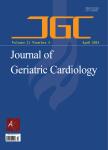Prevalence of and risk factors for aspirin resistance in elderly patients with coronary artery disease
Prevalence of and risk factors for aspirin resistance in elderly patients with coronary artery disease作者机构:First Geriatric Cardiology Division of South Building Chinese PLA General Hospital 28 Fuxing Road Beijing 100853 China
出 版 物:《Journal of Geriatric Cardiology》 (老年心脏病学杂志(英文版))
年 卷 期:2013年第10卷第1期
页 面:21-27页
核心收录:
学科分类:1002[医学-临床医学] 100211[医学-妇产科学] 10[医学]
基 金:supported by the Military Healthcare Fund the Supporting Fund from the Ministry of Science and Technology of China (Li Fan)
主 题:Aspirin resistance Coronary artery disease Risk factors
摘 要:Objective To assess the prevalence of and related risk factors for aspirin resistance in elderly patients with coronary artery disease (CAD). Methods Two hundred and forty-six elderly patients (75.9 ±7.4 years) with CAD who received daily aspirin therapy (≥75 mg) over one month were recruited. The effect of aspirin was assessed using light transmission aggregometry (LTA) and thrombelastography platelet mapping assay (TEG). Aspirin resistance was defined as ≥20% arachidonic acid (AA)-induced aggregation and ≥70% adenosine diphosphate (ADP)-induced aggregation in the LTA assay. An aspirin semi-responder was defined as meeting one (but not both) of the criteria described above. Based on the results of TEG, aspirin resistance was defined as ≥50% aggregation induced by AA. Results As determined by LTA, 23 (9.3%) of the elderly CAD patients were resistant to aspirin therapy; 91 (37.0%) were semi-responders. As determined by TEG, 61 patients (24.8%) were aspirin resistant. Of the 61 patients who were aspirin resistant by TEG, 19 were aspirin resistant according to LTA results. Twenty-four of 91 semi-responders by LTA were aspirin resistant by TEG. Multivariate logistic regression analysis revealed that elevated fasting serum glucose level (Odds ratio: 1.517; 95% CI: 1.176–1.957; P = 0.001) was a significant risk factor for aspirin resistance as determined by TEG. Conclusions A significant number of elderly patients with CAD are resistant to aspirin therapy. Fasting blood glucose level is closely associatedwith aspirin resistance in elderlyCAD patients.



